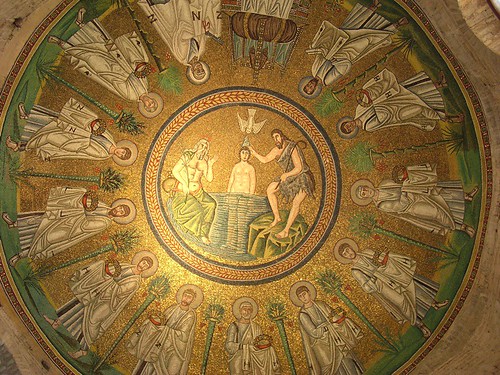
The ceiling of the Arian* baptistry, Ravenna, Italy, 5th C. AD
Father in Heaven, who at the baptism of Jesus in the River Jordan didst proclaim him thy beloved Son and annoint him with thy Holy Spirit: Grant that all who are baptized into his Name may keep the covenant they have made, and boldly confess him as Lord and Saviour; who with thee and the same Spirit liveth and reigneth, one God, in glory everlasting.
___________
*This picture was taken by me on a trip to Italy in 2005, and since it has been made into my desktop art, I scrutinize it daily. I don't detect anything heretical in it, but if others do, I would be pleased to know about it.

5 comments:
I once had a professor (also a Roman priest) who tried to argue that the diminution of the divine genitals was meant to imply the femininity of the only Son of the Father. To that I say: Piffle!
Piffle! And bizarre.
... it is the ARIAN baptistry. - Suspicion somewhat warranted.
I have also had the pleasure of seeing this baptistry in person while I was studying abroad in 2000. According to some notes of mine on this mosaic, there is nothing about the mosaic which can be interpretted as expressly Arian. After examining an art and architecture book, it looks remarkably similar to the Orthodox baptistry built some decades earlier.
Whereas the Arian baptistery has the apostolic procession meeting above Christ's head at the throne with the Cross, so that the apostles are upside-down with respect to Christ, the Orthodox baptistery depicts a procession that meets beneath Christ's feat, so that the head of the procession is subordinated to Christ himself and so that the leading apostles are standing upright in the same direction as is Christ. The orthodox baptistery does not have the throne with the cross as the meeting point of the procession, but simply has Peter and Paul facing each other, directly beneath the feet of Christ. Were I to guess, I would say that the Arian baptistery hints that we can become equal to Christ because of what he achieved on the Cross. Now, of course the orthodox Christians would hold that we become 'divinized' and so our humanity can be sanctified in a manner to Christ's, but since Christ himself is God, we will never stand shoulder-to-shoulder with him, for his divine perrsonhood is transcendently above our created personhood. Perhaps this is why the orthodox baptistery positions Peter and Paul beneath the feet of Christ whereas the Arian has Peter and Paul's heads closest to Christ's, although their bodies face in opposite directions.
Post a Comment